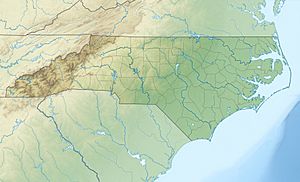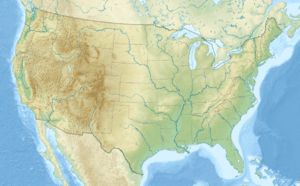Beetree Creek (Swannanoa River tributary) facts for kids
Quick facts for kids Beetree Creek |
|
|---|---|
|
Location of Beetree Creek mouth
|
|
| Other name(s) | Tributary to Swannanoa River |
| Country | United States |
| State | North Carolina |
| County | Buncombe |
| Physical characteristics | |
| Main source | divide between Beetree Creek and Mineral Creek about 0.5 miles southeast of Bearpen Knob 4,520 ft (1,380 m) 35°41′42″N 082°23′35″W / 35.69500°N 82.39306°W |
| River mouth | Swannanoa River about 1 mile northwest of Swannanoa, North Carolina 2,139 ft (652 m) 35°36′39″N 082°25′30″W / 35.61083°N 82.42500°W |
| Length | 8.05 mi (12.96 km) |
| Basin features | |
| Progression | south-southwest |
| River system | French Broad River |
| Basin size | 13.99 square miles (36.2 km2) |
| Tributaries |
|
| Waterbodies | Beetree Reservoir |
| Bridges | Bee Tree Road (x3), Highland Ridge Road, Berkie Lane, Old Beetree Road, Warren Wilson College Road |
Beetree Creek is a small stream, about 8.05 miles (12.96 kilometers) long, located in Buncombe County, North Carolina. It is a "2nd order tributary," which means it's a stream that flows into another stream, which then flows into a larger river. Beetree Creek eventually joins the Swannanoa River.
Where Does Beetree Creek Start and End?
Beetree Creek begins its journey in Buncombe County, North Carolina, starting about half a mile southeast of a place called Bearpen Knob. From there, it flows generally south, then turns to the southwest. Its path ends when it meets the Swannanoa River. This meeting point is about 1 mile northwest of the town of Swannanoa, North Carolina.
What is the Beetree Creek Watershed Like?
A watershed is an area of land where all the water drains into a single stream, river, or lake. The Beetree Creek watershed covers an area of about 13.99 square miles (36.23 square kilometers). This means all the rain and snow that falls in this area will eventually flow into Beetree Creek.
The area around Beetree Creek gets a good amount of rain, about 49.6 inches (126 centimeters) each year. A large part of this watershed, about 92%, is covered by forests. These forests are important because they help keep the water clean and provide homes for many animals.



